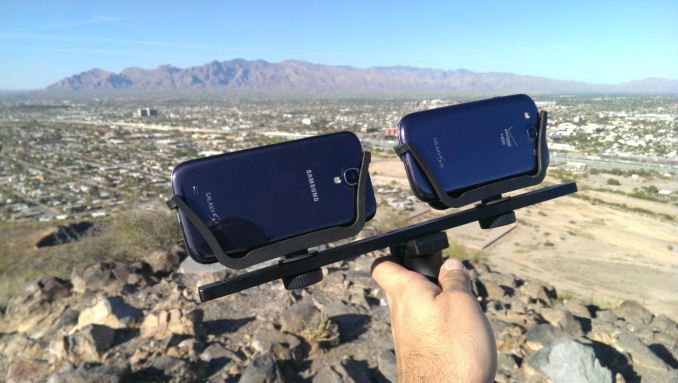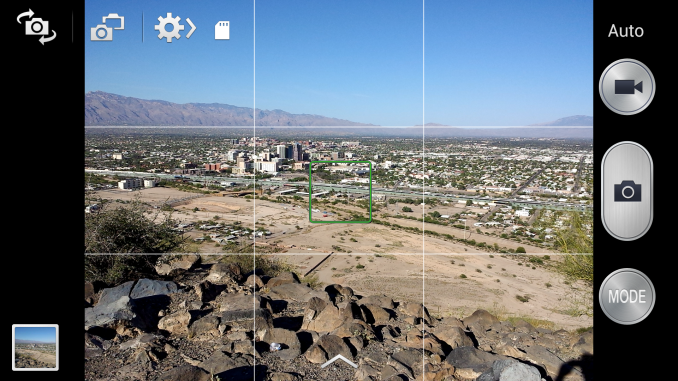Samsung Galaxy S 4 Review - Part 1
by Brian Klug on April 24, 2013 12:01 AM ESTCamera on SGS4
On the camera side Samsung is in an interesting position. The industry trend is overwhelmingly to go to more pixels and push the megapixel count up from 8 MP where most flagships sat last year to around 13 where they will sit this year. Samsung has to push that number to keep itself in a defensible and marketable position and at the same time deliver a camera experience that’s better than the previous year.
I published a table in the One review with the camera specifications from the previous generation. I’ve filled this in with confirmed information from the SGS4 review unit I have been taking samples with. With SGS4 Samsung does make some pretty considerable improvements, many of which undo some of the regressions that I described with SGS3. Focal length is now quite a bit longer, from the very wide SGS3 which was around 26mm in 35mm effective numbers, to 31 mm. This is a notable difference if you’re shooting with the two side by side, the SGS3 was always shockingly wide for a rear facing camera.
| Smartphone Camera Comparison - 2013 | |||||||
| HTC One | Samsung Galaxy S 2 | Samsung Galaxy S 3 | Samsung Galaxy S 4 | ||||
| Front Camera | 2.1MP | 2MP | 1.9MP | 2MP | |||
| Front Camera - CMOS |
OV2722 (1.4µm, 1/5.8") |
- |
S5K6A3 (1.75µm, 1/6") |
S5K6B2 (1.34µm, 1/6") |
|||
| Front Camera - Focal Length | ~1.59mm | 2.73mm | 2.7mm | 1.85mm | |||
| Front Camera - Max Aperture | F/2.0 | F/2.8 | F/2.8 | F/2.4 | |||
| Rear Camera | 4MP | 8MP | 8MP | 13MP | |||
| Rear Camera - CMOS |
ST VD6869 (2.0 µm, 1/3") |
S5K3H2YX (1.4µm 1/3.2") |
Sony/Samsung (1.4µm, ~1/3") |
IMX091PQ (1.12µm, 1/3.06") |
|||
| Rear Camera - Focal Length |
3.82mm (28mm eff) |
3.97mm (30mm eff) |
3.7mm (~26 mm eff) |
4.2mm (31 mm eff) |
|||
| Rear Camera - Max Aperture | F/2.0 | F/2.65 | F/2.6 | F/2.2 | |||
At the same time, F-number has improved dramatically, from the F/2.6 or 2.65 (I’ve seen both at times) aperture on the SGS3 to a much faster F/2.2. This dramatically improves the light collection abilities of the camera, by essentially a half stop. It’s difficult optical design to both keep the module thin enough to fit in the device without creating a huge bump (there’s a camera bump on SGS4, it’s there), increase focal length, improve F/#, and improve MTF for a better sensor all at the same time.
On the rear facing camera we see a Sony CMOS who continues to dominate the space, this time with an IMX091PQ sensor. On the front we Samsung’s own sensor, the S5K6B2 get used. Samsung also continues to go with a dedicated Fujitsu ISP inside the SGS4, this time it’s a new M10MO family which there isn’t a whole lot of information about. I suspect this continues to be done to mitigate the differences in SoC ISP between the APQ8064ab variant and Exynos 5 version and make tuning easier on Samsung’s camera team.
Imaging is increasingly a key differentiator for smartphones since it’s that device you always have on your person to take images with. For SGS4 camera is more of an emphasis this time around than it was with SGS3, which largely kept everything the same and just added software features. SGS4 brings better hardware and additional software features to do something with the hardware.
Outdoors in bright light the increased spatial resolution afforded from going from 8 MP to 13 MP helps. Samsung still does a lot of sharpening and there are halos around a ton of different features if you know where to look, but that’s the tuning they have opted for. I suspect we still are outresolving the sensor here, but I’m impressed with what I see with enough light. I took a lot of photos side by side with SGS3 and find SGS4 a notable improvement, but I’m not sure whether that’s just more damning commentary on SGS3 than anything else. I haven’t had time to put together many side by sides with buttons yet. I’ve been shooting with the HTC One on −2 sharpness since I prefer it that way, note that I accidentally left it this way with when making comparisons here since that’s still my daily driver until I can get an AT&T or T-Mobile SGS4 to use.
In lower light unsurprisingly we see the SGS4 offer better results than the SGS3 but still not quite as good as the HTC One. Samsung recently introduced low light shot on the SGS3 and Note 2, this feature carries over to the SGS4 but gets renamed back to Night Mode, even though behavior appears superficially to be the same. The SGS4 also introduces an auto night mode toggle, although this ships by default turned off. The mode automatically switches on night mode when it senses that you’re going to underexpose using the auto presets, I would advise basically leaving this on all the time. Unfortunately night mode introduces huge shot to shot latency that seems to be on the order of seconds — tap the button, capture runs, then there’s a progress bar that pops up while multiple exposures are ostensibly recombined into one image. You also have to be exceptionally steady to get an image without blur since it appears that this mode takes multiple images to get to the end goal — a better exposed image without tons of noise.
In the end there’s really no free lunch for anyone — you can temporally oversample (Samsung low light shot, or longer exposures with OIS like Nokia), or increase the size of your sampling area (larger pixels a-la HTC One), or do nothing and just give up unless you’re in a bright outdoor setting.
Samsung has introduced a bunch of new photo modes in the software on the SGS4, a number of which are actually pretty functional and awesome. There's the ability to create animated gifs from right in the camera, for example, where users paint a mask around the region they want animated from a short capture. This is essentially the same as Nokia's cinemagraph Lens from the Lumia 920, but it's still quite cool.
There's also dual camera, which lets you include a small overlay of the front facing camera atop the rear facing camera image. It initially struck me as a bit gimmicky but actually can be hilariously fun to share your face atop images to friends. It is also quite possibly the stuff of nightmares.
Panoramas on the SGS4 also are nicely put together and integrate continuously rather than get combined from a number of discrete images. The result is quite nice.
The user interface on SGS4 is a departure from the interface which has been present on previous Galaxy smartphones, and instead takes much UI/UX from the Galaxy Camera. Gone are the customizable toggles on the left side, instead options are in an expandable menu at the very top, and then another separate window. I got used to it pretty quickly but do miss the ability to customize the quick settings buttons on the left side and used to think that Samsung had the most powerful camera interface around. Things are moved around generally in a logical fashion however and I can understand how much this works to make transitioning between Galaxy Camera and SGS4 easy.
Video
When it comes to video, the SGS4 is records 1080p30 video at 17 Mbps H.264 High Profile.
I've done the usual thing and uploaded a sample to YouTube as well as our own servers for your inspection.
Video quality looks really nice and sharp on SGS4 from what I can tell by default. Anti shake (EIS in this case) is disabled out of the box, enabling it pops up a box warning you that stills captured during video record will be a different field of view.






























335 Comments
View All Comments
casteve - Wednesday, April 24, 2013 - link
Thanks for the review - I look forward to Part 2. Also, it's good to know the highway is clear so you can run away from the killer bee swarms.gnx - Wednesday, April 24, 2013 - link
A request to Brian Klug, and Anandtech!Any chance you'd start implementing comparisons of heat measurements for smartphones. Some of these latest flagships have so much horsepower in the them, the back cover heats up quite a bit under heavy use (not only games, but also navigation). It's almost like early light-n-thin laptops that became unusable cause of the heat on the palmrest or underbelly. Just hardware wise, such heat is detrimental to the phone itself in the long term. It could be a problem with last years flagships, so I'm guess this years ones could be more. A more strict analysis/measurement of how these smartphones manage and dissipate heat would be greatly appreciated!
Arbie - Wednesday, April 24, 2013 - link
I'm amazed that people want anything OTHER than plastic in a phone. If you go with anything metallic you have to jump through major technical hoops to get good reception. Why even consider spending all that design money, not to mention making the many unseen compromises that this involves?For me this phone hits all the right points, including these two key items:
• SD card so I can easily swap media sets in and out. Internal fixed memory can't begin to compete with with the speed, capacity, and convenience of micro/SD chips.
• Replaceable battery , so that when it eventually dies I DON'T have to send the phone in for service.
hyperdoggy - Wednesday, April 24, 2013 - link
nothing wrong with plastic, as long as it isn't fisher price plastic.eallan - Thursday, April 25, 2013 - link
which it isdyc4ha - Wednesday, April 24, 2013 - link
Internal memory is much faster than microsd, fact. It is more convenient if everything is in the same place rather than having to swap things out, no? If you really need 32/64GB+ then sure microsd might be better for you, but with USB OTG this is not a big problem at all.sigmatau - Thursday, April 25, 2013 - link
Why did they have to use the cheapest plastic found in 25 cent toys from a gumball machine? I have a plastic phone, a Nokia 900, which kills this phone and any Samsung phone made in feel and durability.superflex - Wednesday, April 24, 2013 - link
The GS4 is evolutionary, not revolutionary.Reminds me of a Cupertino company and their latest phone.
Oh, how the Sammy trolls berated them for that.
HTC One FTW
Shlong - Wednesday, April 24, 2013 - link
And the HTC One is evolutionary (compared to HTC One X).berantle - Wednesday, April 24, 2013 - link
Compared to the HTC One X (and the rest), the HTC One is revolutionary in at least a 3 ways.1. The front-facing stereo speakers. If it was evolutionary, it would have been making a better quality rear-ward facing single speaker.
2. The 4Mp UltraPixel camera. If it was evolutionary, it would have followed the herd towards 13MP camera and even smaller pixel-size sensors than the 8MP camera.
3. The HTC Zoe (which I understand is short for "Zoetrope"). Automatically packaging short movies and photos taken into a simple 30 second presentation. You don't find that with other phones as best as I can see to-date. This is a big change from how it is done by cameras. Reading the reviews of the S4 here and elsewhere, what the S4 is doing seems like a belated response after seeing what the HTC One could do. A lot of people were caught flatfooted by what the HTC Zoe could do.
These are 3 main revolutionary things that the HTC One has done. The S4? I can't see anything revolutionary. The Samsung Galaxy S4 is all about putting everything but the kitchen sink into it. If Samsung could shoehorn the kitchen sink into the S4, they would do it too - just to boast that it has a kitchen sink and no other phone has it.